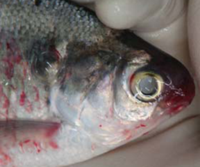
Photo from wikipedia
Viral haemorrhagic septicaemia virus (VHSV) genotype IVb has been responsible for large-scale fish mortality events in the Great Lakes of North America. Anticipating the areas of potential VHSV occurrence is… Click to show full abstract
Viral haemorrhagic septicaemia virus (VHSV) genotype IVb has been responsible for large-scale fish mortality events in the Great Lakes of North America. Anticipating the areas of potential VHSV occurrence is key to designing epidemiological surveillance and disease prevention strategies in the Great Lakes basin. We explored the environmental features that could shape the distribution of VHSV, based on remote sensing and climate data via ecological niche modelling. Variables included temperature measured during the day and night, precipitation, vegetation, bathymetry, solar radiation and topographic wetness. VHSV occurrences were obtained from available reports of virus confirmation in laboratory facilities. We fit a Maxent model using VHSV-IVb reports and environmental variables under different parameterizations to identify the best model to determine potential VHSV occurrence based on environmental suitability. VHSV reports were generated from both passive and active surveillance. VHSV occurrences were most abundant near shore sites. We were, however, able to capture the environmental signature of VHSV based on the environmental variables employed in our model, allowing us to identify patterns of VHSV potential occurrence. Our findings suggest that VHSV is not at an ecological equilibrium and more areas could be affected, including areas not in close geographic proximity to past VHSV reports.
Journal Title: Journal of fish diseases
Year Published: 2017
Link to full text (if available)
Share on Social Media: Sign Up to like & get
recommendations!